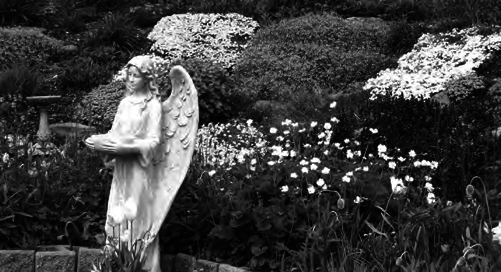100 Perks of Having Cancer: Plus 100 Health Tips for Surviving It (80 page)
Read 100 Perks of Having Cancer: Plus 100 Health Tips for Surviving It Online
Authors: Florence Strang
Tags: #Health; Fitness & Dieting, #Diseases & Physical Ailments, #Internal Medicine, #Oncology, #Cancer, #Medicine & Health Sciences, #Clinical, #Medical Books, #Alternative Medicine, #Medicine

Perk #80
Cancer Taught Me
the Importance of
Living in the Present
A
rabbit who narrowly escapes capture from a fox shows many of the
signs of the “fight-or-flight response”: quick and shallow breathing,
shakiness, and a pounding heart. The fight-or-flight response is a natural
bodily response built into animals (including humans) to help them con-
front or escape danger. When we sense danger, whether it be seeing a bear
walk toward us in the woods, or being told that we have cancer, our fight
or flight response gets activated. Chemicals like adrenaline, noradrenaline,
and cortisol are released into our bloodstream, which causes our body to
undergo some very dramatic changes. Our respiratory rate increases. Blood
is shunted away from our digestive tract and directed into our muscles and
limbs to allow us extra energy and fuel for running and fighting. Our heart
rate quickens, our pupils dilate, and our awareness intensifies. We become
physically and psychologically prepared for fight or flight in the face of
the danger. However, people differ from animals in that we often have our
fight or flight response kicked into full gear long after the real threat of
danger has passed.
Soon after the rabbit escapes capture by the fox, it calms down and goes
back to the business of being a rabbit. It does not go to sleep at night think-
ing,
Jeez, I almost had it today! I could have died. What if that fox had caught
me?
Nor does the rabbit wake up thinking,
I don’t think I’m going to leave
this hole today, that fox could be lurking anywhere.
For those of us who have experienced cancer, the cancer can be likened
to the fox and we to the rabbit. However, unlike a rabbit, many people fail
to live in the present moment. We may continue to live in the past by replay-
ing scenes of our diagnosis and treatments over and over in our minds. Or
we may worry obsessively about the future. (
What if the cancer comes back?
I 337 J

338
100 Perks of Having Cancer
or
How long do I have left?
) If we are to experience peace, we must strive to
be like the rabbit, and just BE in the present moment. The fact that you
are reading this means that you have been given the “gift” of this moment;
that is why it is called the “present.”
Don’t lament the past; don’t worry about the future.
Strive to live in the present moment.
HEALTH TIP #80
Sometimes a Little Worry Can Be a Good Thing
T
here is no doubt that excessive worry will decrease your quality of life
and may be associated with aggravating certain illnesses. According to
the Mayo Clinic, episodes of anxiety can cause dramatic, temporary spikes
in your blood pressure. If those temporary episodes occur frequently, they
can cause damage to your blood vessels, heart, and kidneys.
The thought of living a worry-free life is appealing. But what if I told
you that some degree of worrying can actually make you live longer?
In 1921 a Stanford University psychologist, Lewis Terman, began study-
ing the lives of 1,500 of the brightest boys and girls he could find. Detailed
information was archived about their lives, families, and daily activities as
well as their moods in the hopes of shedding some light on how intelligence
shapes one’s life.
Terman died in 1956, but others were committed to continuing his
study. Published in 2011, a book entitled
The Longevity Project,
by Howard
S. Friedman and Leslie R. Martin, looks at the 1,500 study participants
that were followed over eighty years to determine a broad scope of things.
Among them were the personality factors that led to a long life.
One surprising fact was that cheerful, optimistic children were less likely
to live longer than those who worry a bit. It was explained that the children
who were inherently optimistic and cheerful ended up taking more risks in
their lives. It was theorized that these individuals never thought anything
Perk #80: Cancer Taught Me the Importance of Living in the Present
339
bad would happen, and so they ended up engaging in more risky behaviors
like smoking and drinking. Their activities were also more risky. I imagine
their favorite thing to yell was “Hey guys, watch this!” I’m also thinking they
were a lot of fun at parties.
The individual personality traits that were the strongest indicators for
longevity were prudence, persistence, and being well organized. Conscien-
tious, responsible people developed better social relationships and achieved
more. Because of these qualities, they were given more opportunities in life,
which led to being more fulfilled. They also had more stressful jobs, but
finding meaning in their work changed the stress from being
a negative factor to being a positive factor in their lives, and it
A little bit of worry
ended up having a beneficial effect on their health.
can be a good
While we are all looking for the fountain of youth, much
motivator for making
of it, unfortunately, is out of our control. According to this
healthy changes to
study, genetics accounts for 30 percent of the longevity puzzle.
your life.
For just under one-third of us, we really
will
become our par-
ents. (
Gasp!
)
The bottom line is this: needless worry over things that are out of your
control can do no good. However, if a little worry forces you to act positively,
especially in taking steps to improve your health, it’s a good thing! So don’t
worry . . . or . . . do worry . . . a little.




Perk #81
A Good Reason to Spend
More Time in My Garden
Gardening is a way of showing that you believe in tomorrow.
—AUTHOR UNKNOWN
Flo’s garden in May
A
few years ago, on a sunny day in June, my friend Sherry dropped by
for an unexpected visit and found me in my favorite place: my gar-
den. As I glowed with pride, she commented on my perfectly manicured
flowerbeds, neat rows of veggies, and profusion of healthy shrubs and trees.
“I don’t know how you manage it all!” she exclaimed. “It’s a mystery to me
how you can take care of three kids, run that big house, and still have a gar-
den that looks this good.”
All of the praise must have caused a momentary lapse in my concen-
tration, and I inadvertently invited her inside for a cup of coffee. Hence
I 340 J


